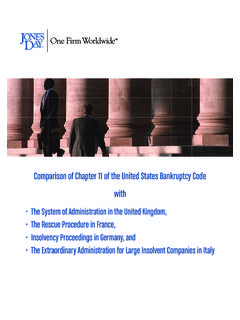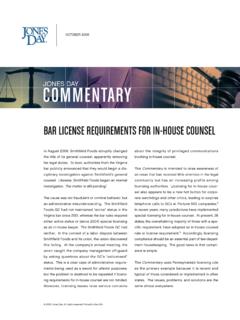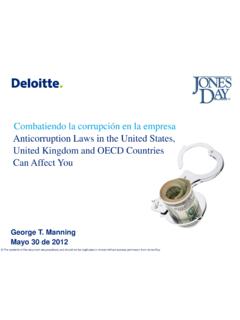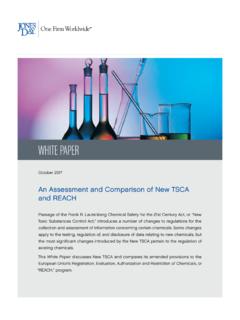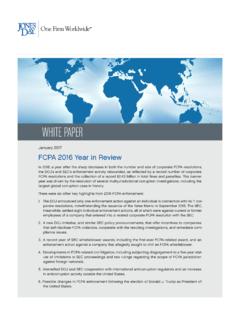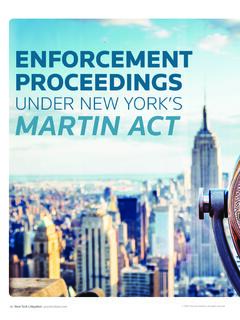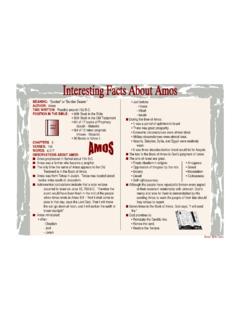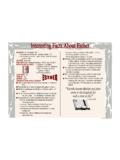Transcription of Section 362(e); Interesting Issues under Sections 351 and 304
1 Section 362(e); Interesting Issues under Sections 351 and 304 William D. Alexander Gordon E. Warnke Internal Revenue Service Partner Associate Chief Counsel (Corporate) Linklaters LLP Scott M. Levine Michelle M. Kwon Partner Associate Professor of Law Jones Day University of Tennessee College of Law San Francisco, CA September 21, 2013 Scott M. Levine, Gordon E. Warnke, Michelle M. Kwon (2013) Topics Section 362(e) Section 362(e)(1) and the Proposed Section 362(e)(1) Regulations Section 362(e)(2) and the Final Section 362(e)(2) Regulations Section 304 and Section 351 Overlaps Allocation of Consideration/Assumed Liabilities 201330004 (July 26, 2013) Recent Guidance Barnes Group Wells Fargo 2 Section 362(e) The Anti-Loss Importation and Anti-Loss Duplication Provisions Section 362(e) Anti-Loss Importation and Anti-Loss Duplication Provisions In general, Sections 362(a) and (b)
2 Provide that if property was acquired by a corporation ( Acquiring ) in connection with a transaction that qualifies as a Section 351 exchange; as paid-in surplus or a contribution to capital; or in connection with a reorganization, then Acquiring s basis in the transferred property is the same as the basis of such property in the hands of the transferor of such property, increased by the amount of gain recognized by the transferor on the transfer. Section 362(e) was enacted in 2004 as part of the American Jobs Creation Act to prevent built-in losses from being imported or duplicated in certain transferred basis transactions.
3 If applicable, Sections 362(e)(1) and (2) may require Acquiring to adjust its basis in certain property received in transactions described in Sections 362(a) and (b). 4 Anti-Loss Importation Rule Section 362(e)(1) Section 362(e)(1) prevents the importation of built-in losses and applies if a transaction: a contribution to capital or qualifies as a Section 351 exchange, a Section 361 exchange, or a Section 368 stock-for-stock exchange ( , the transaction is described in Sections 362(a) or (b)) (each a Section 362 Transaction );* the transfer of Importation Property (defined later); and the importation of a net built-in loss.
4 If Section 362(e)(1) applies to a Section 362 Transaction, the basis of each item of Importation Property in the hands of the Acquiring corporation, regardless of whether it is a built-in loss item or a built-in gain item, is equal to such property s FMV immediately after the transaction ( , each Importation Property must be marked-to -market). Rules similar to Section 362(e)(1) apply under Section 334(b)(2). 5 *See Prop. Treas. Reg. Section (c)(1). Section 362(e)(1) Example X F Prior to Transaction (in hands of F) After Transaction (in hands of X) Asset 1 Asset 1 A/B $100 FMV $60 BIL $(40) Asset 1 A/B $60 FMV $60 BIL $0 6 Importation of a Net Built-In Loss Section 362(e)(1)(C) A transaction results in an importation of a net built-in loss if Acquiring s aggregate adjusted basis in the Importation Property would (but for Section 362(e)(1)) exceed the aggregate FMV of such property immediately after the transaction.
5 The statute is arguably unclear as to whether an importation of net built-in loss is determined by: aggregating the Importation Property transferred by all transferors in a single transaction, or looking at Importation Property on a transferor-by-transferor basis. 7 Prop. Treas. Reg. Section On September 6, 2013, REG-161948-05, 78 Fed. Reg. 54971, was released containing proposed regulations under Sections 334(b)(1)(B) and 362(e)(1) (the Proposed Regulations ). The Proposed Regulations provide that Acquiring s basis in Importation Property acquired in a Loss Importation Transaction is equal to the value of the property immediately after the transaction.
6 The determination as to whether property is Importation Property is based upon a hypothetical sale construct. Prop. Treas. Reg. Section (c)(2). A Loss Importation Transaction generally is any Section 362 Transaction in which Acquiring s aggregate basis in all Importation Property received from all transferors in the transaction would exceed the aggregate value of such property immediately after the transaction. Prop. Treas. Reg. Section (c)(3). The Proposed Regulations do not address how a foreign transferor with a functional currency that is not the dollar should calculate basis in property potentially subject to Section 362(e)(1).
7 8 Prop. Treas. Reg. Section (f) Example 1, Scenario (i) ( Section 351 Transaction) A1, A2, and A3 are Importation Properties. The transfer is a Section 362 Transaction. DC Assets A1, A2 & A3 Prior to Transaction (in hands of FC) Asset A1 A/B $40 FMV $150 BIG $110 Asset A2 A/B $120 FMV $30 BIL $(90) Asset A3 A/B $140 FMV $20 BIL $(120) After Transaction (in hands of DC) Asset A1 A/B $150 FMV $150 BIG $0 Asset A2 A/B $30 FMV $30 BIL $0 Asset A3 A/B $20 FMV $20 BIL $0 FC 9 Prop. Treas. Reg. Section (f) Reorganization Example Assume all facts are the same as in Example 1, Scenario (i), except that FC merges into a disregarded entity wholly owned by DC in a reorganization described in Section 368(a)(1)(A).
8 The results and analysis are the same as in Example 1, Scenario (i) on the previous slide. Prior to Transaction (in hands of FC) Asset A1 A/B $40 FMV $150 BIG $110 Asset A2 A/B $120 FMV $30 BIL $(90) Asset A3 A/B $140 FMV $20 BIL $(120) After Transaction (in hands of DC) Asset A1 A/B $150 FMV $150 BIG $0 Asset A2 A/B $30 FMV $30 BIL $0 Asset A3 A/B $20 FMV $20 BIL $0 FC DC F DRE FC merges into F DRE 10 Prop. Treas. Reg. Section (f) Example 2: Aggregate Approach FC DC F Assets A1 & A2 Asset A3 Prior to Transaction Asset A1 A/B $40 FMV $150 BIG $110 Asset A2 A/B $120 FMV $30 BIL $(90) Asset A3 A/B $140 FMV $20 BIL $(120) After Transaction (in hands of DC) Asset A1 A/B $150 FMV $150 BIG $0 Asset A2 A/B $30 FMV $30 BIL $0 Asset A3 A/B $20 FMV $20 BIL $0 A1, A2, and A3 are Importation Property.
9 The results are the same as in Example 1, Scenario (i). Even though FC is not transferring property with a net built-in loss, Prop. Treas. Reg. Section (c)(3) states that the aggregate approach applies so both transfers in the aggregate constitute a Loss Importation Transaction. 11 Definition of Importation Property Section 362(e)(1)(B) Importation Property is any property if: (i) gain or loss with respect to such property is not subject to [ federal income tax] in the hands of the transferor immediately before the transfer, and (ii) gain or loss with respect to such property is subject to such tax in the hands of [Acquiring] immediately after such transfer.
10 The statute is not clear about whether Importation Property includes property held by a: CFC; Foreign person engaged in a trade or business; or RIC, REIT, cooperative, estate, or trust. 12 Importation Property Definition Clarified Prop. Treas. Reg. Section (d) and (e) The Importation Property determination depends on a hypothetical sale of the property by the transferor before the transaction and Acquiring after the transaction. This construct could lead to different results when compared to a rule that examines whether the seller would actually have any federal income tax liability in the taxable year of the transaction.

